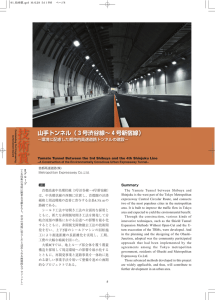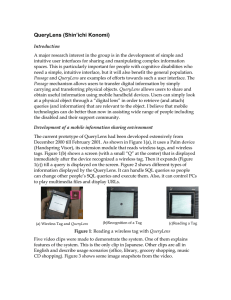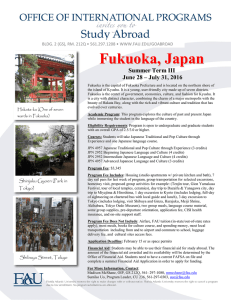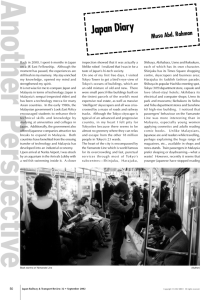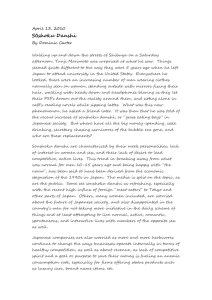Un/Wrapping Shibuya - RMIT Research Repository
advertisement
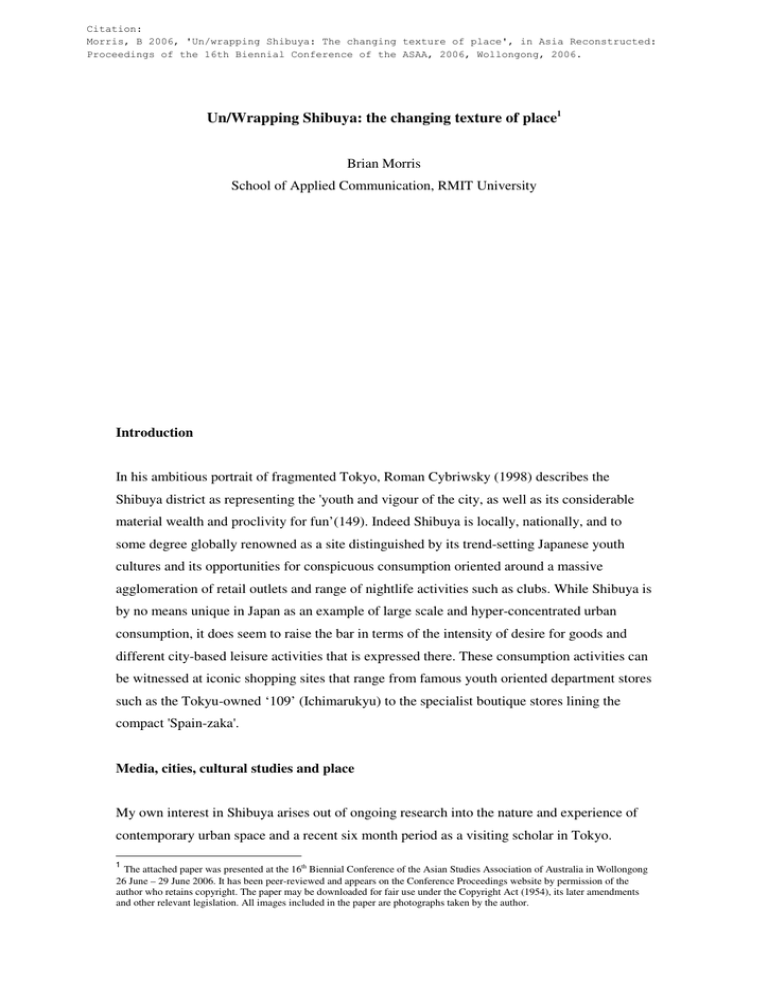
Citation: Morris, B 2006, 'Un/wrapping Shibuya: The changing texture of place', in Asia Reconstructed: Proceedings of the 16th Biennial Conference of the ASAA, 2006, Wollongong, 2006. Un/Wrapping Shibuya: the changing texture of place1 Brian Morris School of Applied Communication, RMIT University Introduction In his ambitious portrait of fragmented Tokyo, Roman Cybriwsky (1998) describes the Shibuya district as representing the 'youth and vigour of the city, as well as its considerable material wealth and proclivity for fun’(149). Indeed Shibuya is locally, nationally, and to some degree globally renowned as a site distinguished by its trend-setting Japanese youth cultures and its opportunities for conspicuous consumption oriented around a massive agglomeration of retail outlets and range of nightlife activities such as clubs. While Shibuya is by no means unique in Japan as an example of large scale and hyper-concentrated urban consumption, it does seem to raise the bar in terms of the intensity of desire for goods and different city-based leisure activities that is expressed there. These consumption activities can be witnessed at iconic shopping sites that range from famous youth oriented department stores such as the Tokyu-owned ‘109’ (Ichimarukyu) to the specialist boutique stores lining the compact 'Spain-zaka'. Media, cities, cultural studies and place My own interest in Shibuya arises out of ongoing research into the nature and experience of contemporary urban space and a recent six month period as a visiting scholar in Tokyo. 1 The attached paper was presented at the 16th Biennial Conference of the Asian Studies Association of Australia in Wollongong 26 June – 29 June 2006. It has been peer-reviewed and appears on the Conference Proceedings website by permission of the author who retains copyright. The paper may be downloaded for fair use under the Copyright Act (1954), its later amendments and other relevant legislation. All images included in the paper are photographs taken by the author. 2 Specifically, I’m concerned in how urban experience is mediated and mediatised at an individual and collective experiential level. My work (eg, Morris 2001; Morris 2004) is situated within a cultural studies tradition interested in reading contemporary city culture as being informed by modernity’s broader conjunction of new experiences of the modern city and media technologies. That genealogy informs the distinct cultural imaginaries of the urban which even today frames globalised yet still place-specific everyday practices and experiences of cities. Exemplary of this approach is the 1920s-30s work of the literary and cultural theorist Walter Benjamin (1999) and his writings on 19th century Paris. Benjamin’s crucial contribution to the study of city cultures was his recognition of the ways in which the sensorily enhanced, high speed and fragmented conditions of modern urban life--as well as its prototypical spaces of consumption such as the shopping arcade--had historical correlates in the formal principles that characterized contemporaneous media technologies such as cinema (so city living and cinema for him are both in a sense forms of spectatorship based on the shared principle of ‘distraction’). Modern city experience was the experience of living with and through the perceptual apparatus of media.2 The examination of changing experiences of everyday urban life was Benjamin’s way to make the modern city and its historical specificities legible. In a more recent iteration of this tradition of inquiry, Ben Highmore (2005) notes that the predominant rationale for many studies of 19th and 20th century urban cultures, particularly those conducted by urban and social planners, was a concern with idea of making the city legible, driven by a desire to control the heterogeneity of the social. Such an orientation underwent a broad range of criticisms in the twentieth city. Trying to articulate a different approach for urban cultural studies today, Highmore suggests instead, in his study of cinema and the city, that ‘the study of urban cultures could declare its object to be the social anxiety caused by the city’s perceived illegibility’, with the aim of making ‘legible the effects and affects of illegibility’(2005: 7). Likewise I am concerned here with the broader roles of media technologies (from mobile telephones to cinema) in producing and staging these anxieties as well as responses to them. At the same time, these cultural studies approaches have arguably less attentive to the embodied experiences of particular places in favour of analysis of their discursive constructions. Shibuya offers an excellent opportunity to bring these two modes of critical analysis together in order to provide a richer description of this simultaneously imagined and lived place. 2 As Benjamin (1968) famously noted in a frequently quoted essay: ‘Our taverns and our metropolitan streets, our offices and furnished room, our railroad stations and our factories appeared to have us locked up hopelessly. Then came the film and burst this prison-world asunder by the dynamite of the tenth of the city, so that now, in the midst of its far-flung ruins and debris, we calmly and adventurously go traveling' (236). 3 Un/wrapping Shibuya Shibuya is located in the south-west pocket of central city Tokyo on the traditionally affluent western high ground, the yamanote of Edo times. While Tokyo lacks a downtown in the western sense, it does have a number of extraordinarily dense and thriving satellite or suburban feeder cities located on the JR Yamanote loop line--such as Shinjuku, Shibuya, Roppongi, Ikebukuro and so on—that function as crucial sites of consumption, mobility, and a range of other urban activities. Their function for many is as node connecting points of work and home; as such they are sites of rapid in and out-flows of bodies of commuters and visitors (Shibuya is ranked second after Shinjuku as the busiest rail station in the world). These places are sites of mobility and transit as much as they are static ‘centres’ of activity. My study focuses on ‘Shibuya’3, a shorthand reference for the area around the conjoined complex of busy railway stations as it radiates out to the north and west of the JR Yamanote line stop (what Linhardt (1998) characterizes as a contemporary version of the Japanese urban form of the sakariba, literally a ‘place where many people come together’). The ‘natural’ topography of the area is that of a basin which descends from the western and also northern higher ground of Harajuku and Yoyogi park. The area is physically defined by a number of natural as well as more recently human constructed boundaries: for instance, running eastwest to the south of the station is the formidable ‘brick wall’ of the metropolitan expressway. The northern boundary of Shibuya is partly defined by the massive NHK broadcasting complex. Like other Japanese city districts it has a familiar urban morphology consisting of a central and extraordinarily busy railway station acting as a hub to retail areas, amusement quarters, an area of office towers, love hotels, and peripheral residential apartment housing. While not having an industrial history, more recently Shibuya has become known as a centre of post-industrial production by being home to the second largest concentration of web and multimedia businesses in Tokyo (see Arai et al (2004)) and is known as ‘Bit valley’ (a play on the meaning of Shibuya’s name, ‘bitter valley’). The sheer diversity, scale and energy of Shibuya arguably make it resistant to singular descriptions or readings4. Additionally, as Highmore indicates, this is not necessarily the most useful or politically desirable way to make sense of such urban places. My own approach also differs significantly from Highmore’s in that I want to move beyond an analysis of the 3 My study utilizes the popular, local understanding of Shibuya. This is distinguished from Shibuya-ku, one of the twenty-three wards that make up central Tokyo--a broader area containing within it other famous urban areas such as nearby Harajuku, Daikanyama and Ebisu. 4 While not focused on Shibuya, see Suzuki’s (2001:48-55) recent analysis of Tokyo for an innovative account of the city’s distinctive urban form and the centrality of communication systems to its inhabitants daily lives and experience. 4 cultural repertoire of circulating city images which form the focus of his study, and examine the place of media technologies more strongly (in relation to Benjamin) to the lived experience of places like Shibuya. Partly this is driven by a simple recognition that new communication technologies like mobile telephones are either usurping or radically remediating older forms such as cinema and their role in the constitution of urban experience and place. Joy Hendry’s Wrapping Culture (1993) offers a generative critical perspective that can help theoretically refigure the study of the relations between place, media technologies and urban experience. Hendry begins her social anthropological account with an examination of the significance of wrapping in Japan in relation to gifts but extends it as an analytic to consider the wrapping/unwrapping of language, space and temporality. The value of her work for me has two crucial dimensions. Firstly, her work does have a general applicability to cultural practices beyond those found in Japan: while her empirical materials may be Japanese she is not arguing that her analytic is identifying some essential Japanese trait (un/wrapping can usefully describe social processes as they occur in other cultures—and the differences between cultures in such processes are a source of revealing potential misunderstanding). Secondly, rather than looking for legibility in the traditional sense (that is, meaning residing within objects and/or spaces themselves), Hendry puts forward the persuasive argument that a study of wrapping and unwrapping, of social space for instance, helps to disentangle us from a problematic focus on the search for an underlying essence in our object of study by encouraging us to shift our analytical gaze to the different modes of social interaction, ritual and everyday experience that involve complex and revealing processes of social ‘un/wrapping’. As she notes: [there is a] problem in our Western propensity to want always to be unwrapping, deconstructing, seeing the objects at the centre of things. Bognar, too, comments about Japanese cities that “if we try to lift the veils wrapping them in endlessly juxtaposed layers, surprisingly … [they] become “empty”’ (1985:67). Undoubtedly, what we need to do, is to learn to value the wrapping, as well as the wrapped, and seek the meaning they together convey.’ (109) Hendry’s notion of wrapping provides a way of thinking how an appropriate analytical description of the texture of contemporary mediatised places might be undertaken. Rather than describing an essential and static Shibuya, it provides a framework through which a socially and technologically mediated place and its fluid meanings might be more complexly described and analysed. Hendry’s book does address the spatial arrangements of the 5 traditional Japanese home, Japanese castles and the Imperial palace, public buildings and sacred sites such as shrines: to my mind it also provides a useful starting point from which to examine contemporary city places such as Shibuya within the conceptualization of them identified by cultural studies; that is, as sites of ‘both cultural imaginaries and lived cultural experiences’ (Healy 2003, p. 55). Put another way, Shibuya is an imagined space as much as a concrete, actual place. Three brief examples provide a means to illustrate the directions in which a study might proceed. Three Un/Wrappings -Example 1: Big screen Shibuya Among the most striking and dreamlike urban streetscapes of Tokyo represented in the acclaimed ‘indie’ film Lost in Translation (2003), are those featuring Shibuya. In particular the giant and multiple building cum-television-screens that face on to Hachikō Crossing, provide an arresting and monumental urban sight for Tokyo visitor, Charlotte (Scarlett Johansson). Hypnotic and overwhelming giant images on the ‘Q-front’ and ‘SuperLisa’ building screens envelop pedestrians traversing or occupying the streets and Plaza below in a noisy and dissonant mash-up of competing images and soundtracks. At ground level, the street is marked by the rhythm of changing traffic lights and the tidal surge of thousands of people participating in the temporary chaos of the busy and chaotic intersecting scramble crossings (kousaten tsukuramburu) poetically captured in the film in a sea of umbrellas on a rainy day. At one level these screens in Shibuya function as a technology that unwraps and undermines the stability of place by introducing disorienting images of multiple other places from within Japan, from around the globe, and from the fantasy worlds of advertising. These Shibuya screens are maximum scaled exemplars of what Margaret Morse (1998) has identified as increasingly prevalent postmodern everyday environments: ‘[t]he late twentieth century has witnessed the growing dominance of a differently constituted kind of space, a nonspace of both experience and representation, an elsewhere which inhabits the everyday.’ Such nonspaces, Morse argues, are now constitutive of our habitual experience of urban space. Walking through Hachikō Crossing provokes an experience of distraction in which the self is 6 constantly split between a here of Shibuya and a virtual elsewhere. That split is mediated primarily through the cultural technology of the screen. Processes of wrapping are simultaneously occurring in the sense of the screens attempt to ensnare the collective gaze of the passerby. Their scale enables a degree of authority in their address. As Anna McCarthy (2001) notes more generally in her work on the phenomena of ‘ambient television’, TV as a medium encompasses ‘globalizing ideologies of space-binding and "scale-shifting"'(18) through its operation in site-specific places. While not always successful in their attempts at spatial interpellation as they are often encountered in a distracted moment, the supersize screens do attempt to bring together the disparate crowds waiting at the crossing into a collectivity. That attempt works to constitute that increasingly common social subject, the citizen-consumer, who is addressed here in this private-public environment through the insistent flows of image and sound which include rapid, jump cut mixes of advertising as well as narcissistic images of the crowd at the crossing as ‘public’ regularly reflected back to itself. -Example 2: Hachikō Shibuya’s most iconic and well-known landmark is the statue of Hachikō located in the large front area outside of the northeastern exit of the station. The popular myth surrounding this dog tells how during the Taisho era of the 1920s he loyally waited at the station for his master to return. Even when his master had died the dog reputedly continued to wait there for eleven years after. In terms of scale the Hachikō statue is a truly incidental feature in the context of the vast crowds and aforementioned giant screens5. Despite its comparatively modest size, Hachikō’s statue has continued to function as a handy meeting point for those getting together in Shibuya. In his seminal urban planning work, The Image of the City (1960), Kevin Lynch characterised monuments like this as unique nodes in city space—vital landmarks which enabled the cognitive mapping of urban space by inhabitants. Henri Lefebvre (1991: 142-144) argued for their function as sites of ‘intensity’ in urban space, points of capture for certain relations of power and their associated social 5 It took the writer a few visits to find the famous statue as I mistook the Akita reliefs on the wall of the station as being the famous object referred to in my guidebooks. 7 meanings.6 Yet whether that intensity is registered or ‘practiced’ by the passerby is another matter. To sit by Hachikō’s statue is to witness a range of urban activities that include meetings, tourist pilgrimages, and crowd watching: activities that wrap and unwrap the official narrative of Hachikō concerning the desirable quality of loyalty. It is a moment when the imaginary and the concrete come together. Contemporary wrappings of everyday practice around this landmark are increasingly mediated by the small screen of the keitai (mobile telephone) technology. Rather than simply displacing the use of known landmarks like Hachikō as meeting places, the keitai is most frequently used, as Ito and Okabe (2005: 266-269) note from their ethnographic studies, to micro-coordinate rendezvous at mutually known urban places: a series of to-ing and fro-ing text messages typically presage the final physical meeting. A landmark like Hachikō’s statue is no longer a discrete urban node as characterized by Lynch, but what part of what they call a ‘technosocial’ situation; it is site-specific as well as incorporating other places through the electronic connections made. More generally the keitai is helping to engineer a new range of performances, situations, interactions, dispositions within urban space. As Licoppe and Inada (2006) note, such technologies electronically augment our experiences of urban space through their overlay of a virtualized, supplementary geography. -Example 3: The discursive problem of youth My final example returns to the earlier point made regarding Highmore’s suggestion that today ‘the study of urban cultures could declare its object to be the social anxiety caused by the city’s perceived illegibility’(7). While my previous two examples have concerned the interaction of individuals with technologies in their experiences of self, crowd and space in Shibuya, here I turn to the ways in which institutions also work to wrap and unwrap the meanings of this place. The illegibility of the youth culture which is synonymous with Shibuya has been vibrantly captured in Harada Masato’s film, Bounce Kogals (1997). The film’s organising narrative focuses on the journey of Risa, a teenage schoolgirl who has stopped in Shibuya on her way 6 Hachikō became a national celebrity in the 1932 when Tokyo newspapers publicized his story and he arguably became a propaganda vehicle for nationalist values of loyalty in relation to the Japanese war with China at the time. 8 to New York, but is robbed of her savings and drawn into friendship and risky activities with schoolgirls involved in enjo kousai (compensation dating) and teen prostitution rackets. In an early scene when Risa first arrives in Shibuya she is hassled by ‘talent scouts’ while walking the packed streets and Harada vividly captures the dense texture and incredible energy engendered by the presence of the young crowds. At its busiest times, Friday nights and Sundays, these massed bodies wrap the urban landscape of Hachikō Crossing, Centre-gai (the central pedestrian-only shopping street), and the surrounding streets by the force of their mass7. Shibuya has been the locus of an ongoing anxiety about youth and its ‘place’ in the Japanese city. Perhaps the most intense of media debates/moral panics in the last decade has be around the phenomenon of enjo kousai (compensation dating) popularly understood as being driven the consumer desires of luxury brand-hungry kogyaru (schoolgirls)8. Similarly the ganguro (‘black face’) subculture identified with Shibuya and Centre-gai became a topic of condemnation in the self-consciously male press in 1998-1999. The ganguro look was generally characterized by this press as a cultural travesty rather than a style (Miyake cited by Kinsella 2005:145). For Kinsella and others (eg, see Black, forthcoming), this media discussion tapped into national anxieties concerning the intersections of national identity, race and femininity. In these media discourses Shibuya was frequently positioned as both a literal location where this problem is concentrated as well as a metonym for broader social anxieties about contemporary Japanese urban life and society. From the perspective of my study, it is the new uses of media technologies (from pagers to keitai) that provide a central thread weaving in and out of these broader media discourses of concern about youth and places like Shibuya. For example, Matsuda (2005: 26) notes the widespread media attention given to technology adopters such as the mixed gender group, jibetarian (a combination of the Japanese word jibeta for ‘the ground’ and the English suffix arian). Closely associated with areas like Shibuya, jibetarians were identified by their ‘signature practice of squatting or sitting on curbs or in a corner of a shopping street’ (Matsuda 1005: 26). Some of the public criticism Matsuda cites censures “’jibertarian who not only sit on the street but eat and drink there’”(26) and ‘”young people who can’t distinguish public and private”’(26). As she notes, it was the ‘bad manners’ of this group that 7 At other times when such as late night or early morning when the crowds have yet to form, public and corporate parts of the urban fabric of Shibuya such as the frontage of commercial buildings corporate are wrapped in alternative meanings through youth leisure (I regularly witnessed the practice sessions of 'para para' dancers in my 2005 Shibuya fieldwork and this activity also figures in a scene in Bounce Kogals). 8 Kogyaru were young women mainly distinguished by their bleached hair, short miniskirts (often part of school uniforms) with loose socks, their performative use of pagers then keitai, and their practice of taking lots of puri-kura (sticker photos from a booth) (see Matsuda 2005:26). 9 organized the criticisms appearing in local media. Dominant media discourses, in other words, provide evidence of attempts to unwrap and wrap urban youth cultures when their meanings threaten the heterogeneity of the dominant social and urban order. Existing in conjunction with such practices are popular and/or subcultural attempts to tactically resignify everyday urban places through the media resources made available in a consumption-based society. These might range in Shibuya from the practices derived from purikura (coin-operated miniature photos) (see Miller 2005) to the rave demo protests that have taken place in Shibuya’s Miyashita Park (see Hayashi and McKnight 2005). Conclusion Through an examination of the wrappings and unwrappings performed by globally proliferating media technologies and practices it is possible to gain insights into the changing nature of ‘lived’, actual places such as Shibuya, and the increasingly mediatised nature of the contemporary city. For ‘Shibuya’ is not simply a physical location but a complex site at which media technologies--ranging from the miniature to the architectural to the discursive— organize and refigure the intersection of social relations and experiences of place. Works Cited Arai Y, N. H., Sato H, Nakazawa T, Musha T, Sugizaki K (2004). "Multimedia and Internet business clusters in Central Tokyo." Urban Geography 25(5): 483-500. Benjamin, W. (1968). The Work of Art in the Age of Mechanical Reproduction. Illuminations: Essays and Reflections. H. Arendt. New York, Schocken Books: 217-251. Benjamin, W. (1999). The Arcades Project. Cambridge, Mass., Belknap Press of Harvard University Press. Black, D. (forthcoming). "Wearing Out Racial Discourse: Tokyo Street Fashion and Race as Style." Journal of Popular Culture. Certeau, M. d. (1984). The Practice of Everyday Life. Berkeley, University of California Press. Cybriwsky, R. (1998). Tokyo: The Shogun's City at the Twenty-First Century. Chichester, Wiley. Donald, J. (1999). Imagining the Modern City. London, Athlone Press. Hayashi, S. and A. McKnight (2005). "Good-bye Kitty Hello War: The Tactics of Spectacle and New Youth Movements in Urban Japan." Positions: East Asia Cultures Critique 13(1): 87-113. Healy, C. (2003). The City. Interpreting Everyday Life. F. Martin. London, Edward Arnold: 54-66. Hendry, J. (1993). Wrapping Culture: Politeness, Presentation and Power in Japan and Other Societies. Oxford, Oxford University Press. Highmore, B. (2005). Cityscapes: Cultural Readings in the Material and Symbolic City. Houndmills, Basingstoke, Palgrave Macmillan. Ito, M. and D. Okabe (2005). Technosocial Situations: Emergent Structuring of Mobile E-mail Use. Personal, Portable, Pedestrian: Mobile Phones in Japanese Life. M. Ito, D. Okabe and M. Matsuda. Cambridge Mass., MIT Press: 257-273 Kinsella, S. (2005). Black Faces, Witches, and Racism against Girls. Bad Girls of Japan. L. Miller and J. Bardsley. New York, Palgrave Macmillan. Lefebvre, H. (1991). The Production of Space. Oxford, Basil Blackwell. Licoppe, C. and Y. Inada. (2006). “Emergent Uses of a Location-aware Multiplayer Game: The Interactional Consequences of Mediated Encounters”. Mobilities 1(1): 39-61. 10 Linhardt, S. (1986). Sakariba: Zone of Evaporation Between Work and Home. Interpreting Japanese Society. J. Hendry and J. Webber. Oxford, JASO: 198-211 Lynch, K. (1960). The Image of the City. Cambridge, MA, M.I.T Press. Matsuda, M. (2005). Discourses of Keitai in Japan. Personal, Portable, Pedestrian: Mobile Phones in Japanese Life. M. Ito, D. Okabe and M. Matsuda. Cambridge Mass., MIT Press: 19-39. McCarthy, A. (2001). Ambient Television : Visual Culture and Public Space, Duke University Press. Miller, L. (2005). Bad Girl Photography. Bad Girls of Japan. L. Miller and J. Bardsley. New York, Palgrave Macmillan. Morris, B. (2001). Architectures of Entertainment. Virtual Globalization: Virtual Spaces/Tourist Spaces. D. Holmes. London, Routledge: 205-219. Morris, B. (2004). Screening Los Angeles: Architecture, Mobility and Migrancy. Drifting: Architecture and Migrancy. S. Cairns. London, Routledge: 252-270. Morse, M. (1998). Virtualities : television, media art, and cyberculture. Bloomington, Indiana University Press. Suzuki, A. (2001). Do Android Crows Fly Over the Skies of an Electronic Tokyo? The Interactive Urban Landscape of Japan. London, Architectural Association.


